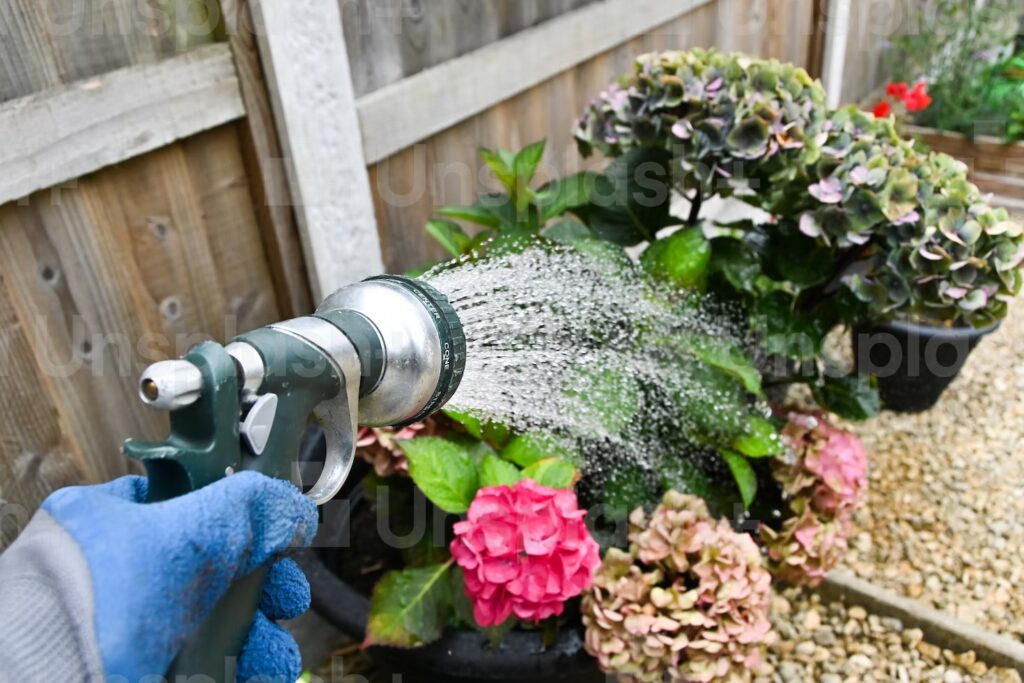Hydrangeas are beautiful flowering shrubs that are popular for their showy blooms and ease of care. They are a group of popular and versatile plants that are widely grown for their large, showy flowers and attractive foliage. There are many different species of hydrangeas, each with unique characteristics and growing requirements.
Whether you’re looking for a plant for a shady spot in your garden or a colourful accent for a sunny border, there’s a hydrangea that’s just right for you. With proper care, hydrangeas can provide years of beauty and enjoyment, making them a great choice for gardeners of all skill levels.

Table of Contents
How to care for a Hydrangea
Hydrangeas grow best in moist, well-drained soil with a slightly acidic to neutral pH of 5.5 to 6.5. They prefer partial to full shade but will tolerate some morning sun. Make sure to plant hydrangeas in a location that protects from strong winds. They need a lot of water, especially during hot weather. Make sure to water deeply and regularly to keep the soil consistently moist but not waterlogged. You should fertilize hydrangeas in early spring and mid-summer with a balanced, slow-release fertilizer. Avoid using too much fertilizer, as this can result in excessive leaf growth and fewer flowers.
You should prune hydrangeas after flowering to encourage new growth and control their size. Cut back old, woody stems to encourage new growth from the base of the plant. If you have a mophead or lace-cap hydrangea, prune only the tips of the stems. Hydrangeas are hardy in most climates, but in colder regions, they may need some protection from winter cold and drying winds. Mulching around the base of the plant can help protect the roots, and wrapping the branches with burlap can help protect the plant from winter winds.
Hydrangeas are relatively disease-resistant, but they can be affected by fungal diseases like powdery mildew and leaf spot. Keep an eye out for pests like aphids and scale insects, which can cause damage to the leaves and stems.

Can hydrangeas grow in hot climates?
Hydrangeas can grow in hot climates, but they may struggle in extreme heat and direct sun. These plants prefer cooler temperatures and partial to full shade, which can be difficult to find in hot climates.
How to grow hydrangeas if you live in a country with a hot climate:
- Plant in a shady location: Find a location that provides some protection from the hot sun, such as near a large tree or on the east or north side of a building.
- Provide adequate moisture: Hydrangeas need a lot of water to keep their leaves from wilting and their blooms from drooping. Make sure to water deeply and regularly, especially during hot, dry spells.
- Mulch around the base of the plant: A layer of mulch can help keep the soil cool and moist, which can help prevent stress in hot weather.
- Protect from the wind: In hot climates, winds can be very drying, which can stress the plant and cause it to wilt. Protect from the wind by planting near a wall or fence, or by using a windbreak.
By following these tips, you can help your hydrangeas survive and thrive in a hot climate. However, if you’re unable to provide the ideal conditions for these plants, they may struggle and may not bloom as well as they would in cooler climates.
Can hydrangeas grow in colder climates?
Yes, hydrangeas can grow in colder climates, but they may need some protection from harsh winter weather. Hydrangeas are hardy in most climates and can tolerate temperatures as low as -20°F (-29°C), depending on the species and cultivar.
How to grow hydrangeas in countries with colder climates:
- Provide winter protection: In cold climates, hydrangeas may benefit from protection from winter cold and drying winds. Mulching around the base of the plant can help protect the roots, and wrapping the branches with burlap can help protect the plant from winter winds.
- Choose the right variety: Some hydrangea species and cultivars are hardier in colder climates than others. For example, the Hydrangea arborescens, Hydrangea anomala, and Hydrangea paniculata are known for their cold tolerance.
- Plant in a sheltered location: Planting in a sheltered location, such as near a wall or under the protection of taller trees, can help protect hydrangeas from harsh winter winds.
- Avoid pruning late in the season: Pruning late in the season can stimulate new growth that may not have time to harden off before winter, making it more susceptible to winter damage. Prune hydrangeas in early spring or after the threat of frost have passed.
How often do I need to water hydrangeas?
Hydrangeas need a lot of water, especially during hot weather. It’s important to keep the soil consistently moist but not waterlogged, which can lead to root rot. The frequency of watering will depend on several factors, including the climate, soil type, and size of the plant.
Guidelines for watering hydrangeas:
- Water regularly: Hydrangeas should be watered regularly, especially during hot, dry spells. A good rule of thumb is to water once a week, or more often if the soil feels dry to the touch.
- Water deeply: When you water, make sure to water deeply to encourage deep root growth. Slowly pour water around the base of the plant until it reaches the roots, and let it soak in for a few minutes before moving on to the next plant.
- Check the soil: Before watering, check the soil to see if it’s moist or dry. If the top inch of soil is dry, it’s time to water. If it’s still moist, you can wait a few more days before watering again.
- Use mulch: A layer of mulch around the base of the plant can help retain moisture in the soil and reduce the need for frequent watering.
By following these guidelines, you can help ensure that your hydrangeas receive the water they need to thrive. However, it’s important to be mindful of the conditions in your specific location and adjust your watering schedule as needed.


How often do I need to prune hydrangeas?
The frequency of pruning for hydrangeas will depend on the type of hydrangea and the desired shape of the plant. Here are some general guidelines for pruning different types of hydrangeas:
- Mophead and Lacecap/French Hydrangeas (Hydrangea macrophylla): These types of hydrangeas flower on old wood, so they should be pruned immediately after flowering in the summer. Pruning too late in the season can remove the flower buds for the next year, so it’s important to prune at the right time.
- Panicled Hydrangeas (Hydrangea paniculata): These hydrangeas flower on new wood, so they can be pruned in late winter or early spring before new growth begins. Pruning in late winter or early spring can also help maintain the desired shape of the plant.
- Smooth Hydrangeas (Hydrangea arborescens): These hydrangeas can be pruned in late winter or early spring to remove any winter damage or to maintain the desired shape of the plant.
Regardless of the type of hydrangea, it’s important to use clean, sharp pruning shears and to avoid over-pruning, which can stress the plant and reduce flowering. By following these guidelines, you can help ensure that your hydrangeas are properly pruned for optimal health and beauty. If you’re unsure about the best time to prune your specific type of hydrangea, it’s always a good idea to consult with a local nursery or horticulturist for advice.
How do I protect my hydrangeas from pests and diseases?
- Choose a suitable location: Planting hydrangeas in a location with well-draining soil and good air circulation can help reduce the risk of pest and disease problems.
- Avoid overwatering: Overwatering can create conditions that are conducive to disease, so it’s important to water hydrangeas only when the soil is dry to the touch.
- Practice good hygiene: Keeping the area around your hydrangeas clean and free of debris can help reduce the risk of pest and disease problems. This includes removing fallen leaves, flowers, and other plant material promptly.
- Inspect regularly: Regularly inspecting your hydrangeas can help you detect pests and diseases early when they are easier to treat. Look for signs of damage, such as yellowing leaves, holes in leaves, or sticky residue on the leaves and stems.
- Use insecticides and fungicides: If pests or diseases do become a problem, there are many effective insecticides and fungicides available to help control them. Be sure to follow the label instructions carefully and choose a product that is appropriate for your specific pest or disease problem.

By following these tips, you can help keep your hydrangeas healthy and free from pests and diseases. However, it’s always a good idea to consult with a local nursery or horticulturist for advice if you’re unsure about the best way to protect your specific type of hydrangea.
Conclusion
In conclusion, hydrangeas are popular and beautiful plants that can add a touch of elegance to any garden. To ensure that your hydrangeas thrive, it’s important to choose the right location, provide proper watering, and pruning at the right time, and protect them from pests and diseases. By following these guidelines, you can help ensure that your hydrangeas are healthy, beautiful, and long-lasting.
